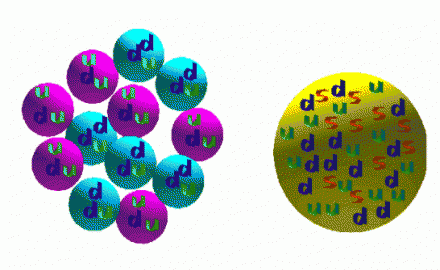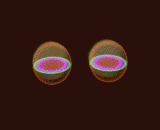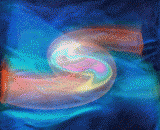AMS at Yale
The Alpha Magnetic Spectrometer (AMS) is a particle detector that began operation on the International Space Station in May 2011. Its large acceptance and excellent resolution for cosmic ray track measurements make it well suited for a wide range of physics topics.The main interest of the Yale group (led by Professor Jack Sandweiss) is to use AMS to search for the presence of Strangelets (small chunks ofstrange quark matter) in cosmic rays, a task for which it is extremetly well suited. More details about AMS can be found at the AMS homepage

Strange Quark Matter
Strange Quark Matter (called “strangelets” in small chunks) is a possible form of hadronic matter containing approximately equal (and potentially very large) numbers of up, down, and strange quarks inside a single hadronic bag. (The addition of strange quarks to a bag of up and down quarks lowers the coloumb and fermi energies of such an object and thus increases its stability compared with two-flavor quark matter) Edward Witten has suggested that SQM may be the true ground state of bulk hadronic matter and this remains a valid possibility for states with baryon numbers roughly greater than 100. Searches for smaller strangelets with baryon numbers of a few, which may be quasi-stable, have been carried out at heavy-ion accelators but none have thus far been found, and the results of these experiments indicate that it will be very difficult to create strangelets in the manner.

However, if strange quark matter in bulk is stable at zero pressure (as it may be) then the objects commonly thought of as neutron stars are in fact strange stars , or very, very large strangelets (Indeed, all previous observations of these objects are believed to be consistent with either hypothesis). If this is the case, then fragments of these strange stars will occasionally be ejected by collisions of these stars and thus strangelets will become a component of cosmic rays.





Models of such collisions and estimates of their rates indicate that if bulk SQM is stable at zero pressure, then AMS is very likely to observe strangelets. The discovery of such a new state of matter would be have numerous implications, including implications for the study of hadronic matter and QCD, for cosmology (the early universe is believed to have existed for some time in a state of hot quark matter), for chemistry (atoms with strangelets as nuclei could exist up to nuclear charge of around 1000), and for energy production (a potential source of very clean fusion energy).